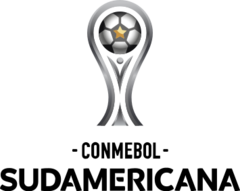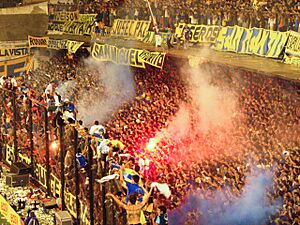Copa Sudamericana facts for kids
 |
|
| Organizing body | CONMEBOL |
|---|---|
| Founded | 2002 |
| Region | South America |
| Number of teams | 56 (from 10 associations) |
| Qualifier for | Recopa Sudamericana Copa Libertadores UEFA–CONMEBOL Club Challenge |
| Related competitions | Copa Libertadores (1st tier) |
| Current champion(s) | |
| Most successful club(s) |
|
| Television broadcasters | List of broadcasters |
The CONMEBOL Sudamericana, often called Copa Sudamericana, is a big international football competition for clubs in South America. It's organized every year by CONMEBOL, which is the main football group for South America. This tournament started in 2002.
The Copa Sudamericana is the second most important club competition in South American football. It's like a championship for teams that didn't qualify for the top tournament, the Copa Libertadores. The team that wins the Copa Sudamericana gets to play in the Recopa Sudamericana, which is a supercup against another champion. They also get a spot in the next Copa Libertadores and play a special friendly match called the UEFA–CONMEBOL Club Challenge against the winners of the UEFA Europa League from Europe.
The current champion is Racing from Argentina. They won the 2024 Copa Sudamericana final by beating Cruzeiro from Brazil. Clubs from Argentina have won the most titles, with ten victories. Five clubs have won the tournament twice: Boca Juniors, Independiente, Athletico Paranaense, Independiente del Valle, and LDU Quito. Boca Juniors is the only team to win two years in a row, in 2004 and 2005.
Contents
- What is the History of the Copa Sudamericana?
- How Does the Tournament Work?
- What is the Copa Sudamericana Trophy?
- What Does "The Other Half of Glory" Mean?
- Who Sponsors the Copa Sudamericana?
- What is the Official Match Ball?
- How Much Prize Money Do Teams Win?
- How Can You Watch the Copa Sudamericana?
- Who Has Won the Copa Sudamericana?
- Images for kids
- See also
What is the History of the Copa Sudamericana?
Before the Copa Sudamericana, there were other football tournaments in South America. In 1992, the Copa CONMEBOL was created for clubs that didn't play in the biggest tournaments. This cup ended in 1999.
Then, the Copa Merconorte and Copa Mercosur started in 1998. These tournaments also ended in 2001. The Copa Sudamericana began in 2002 to replace these older competitions. It started as a knockout tournament, meaning teams were eliminated if they lost. The first winner was San Lorenzo.
How Does the Tournament Work?
The Copa Sudamericana is a knockout tournament, which means teams play matches and the loser is out. The number of teams and rounds has changed over the years.
Until 2016, 47 teams played. Teams from Argentina and Brazil would join later in the tournament. Starting in 2017, the tournament got bigger, with more teams. It also began to run for most of the year, from February to December.
A big change happened in 2021 when a group stage was added. This means teams first play several matches in groups, and then the best teams move on to the knockout rounds. Also, some teams that get eliminated from the Copa Libertadores (the top South American club competition) can join the Copa Sudamericana later in the tournament. This makes the competition even more exciting!
What is the Copa Sudamericana Trophy?
The trophy given to the winner of the tournament is also called the Copa Sudamericana. Sometimes people just call it la Sudamericana. It's a special prize for the champions.
What Does "The Other Half of Glory" Mean?
La Otra Mitad de La Gloria is a Spanish phrase that means "The other half of glory." It's a popular saying used to describe winning the Copa Sudamericana. It shows how important and respected this tournament has become among football fans and teams. For example, when Cienciano won in 2004, it was a huge celebration in Peru!
Who Sponsors the Copa Sudamericana?
Big companies help sponsor the Copa Sudamericana, just like other major sports events. These sponsors help fund the tournament. The first main sponsor was Nissan Motors, starting in 2003.
As of 2024, some of the official sponsors include:
- Amstel Brewery
- Coca-Cola
- Entain (which includes Bwin and Sportingbet)
- EA Sports
- Mercado Libre
- Midea Group
- MG Motor
- Ueno Bank
There are also official partners like DHL and Puma.
What is the Official Match Ball?
Since 2024, the German company Puma makes the official match ball for the Copa Sudamericana, as well as for other CONMEBOL competitions. The official match ball for the 2024 tournament was called the Puma Cumbre.
How Much Prize Money Do Teams Win?
Winning the Copa Sudamericana can bring a lot of prize money to the clubs. For the 2023 Copa Sudamericana, teams received money for playing matches and even more for winning. For example, clubs that reached the group stage got US$900,000, plus US$100,000 for each match they won in that stage.
The further a team goes in the tournament, the more money they earn. The team that finishes second (the runner-up) receives US$2,000,000, and the champions get a big prize of US$5,000,000! This money comes from TV rights and advertising.
How Can You Watch the Copa Sudamericana?
Since 2019, the Copa Sudamericana has had separate TV deals from the Copa Libertadores. In Latin America (outside Brazil), you can watch it on DSports. In Brazil, it's broadcast on channels like SBT, ESPN, and Paramount. You can also find highlights on OneFootball.
Who Has Won the Copa Sudamericana?
List of Finals
- From 2005 to 2008, clubs from North and Central America (CONCACAF) were invited to play.
- Since 2019, the final is played as a single match, not two legs.
- Keys
- Finals won on away goals
- Match went to extra time
- Defined on penalty shoot-out in the second leg
| Year | Winners | 1st. leg |
2nd. leg |
Agg. | Runners-up | Venue (1st leg) |
City (1st leg) |
Venue (2nd leg) |
City (2nd leg) |
|---|---|---|---|---|---|---|---|---|---|
| 2002 |
|
|
|
Estadio Atanasio Girardot | Medellín | Estadio Pedro Bidegain | Buenos Aires | ||
| 2003 |
|
|
|
Estadio Antonio V. Liberti | Buenos Aires | Estadio de la UNSA | Arequipa | ||
| 2004 |
|
|
|
Estadio Hernando Siles | La Paz | La Bombonera | Buenos Aires | ||
| 2005 |
|
|
|
Estadio Olímpico Universitario | Mexico City | La Bombonera | Buenos Aires | ||
| 2006 |
|
|
|
Estadio Hidalgo | Pachuca | Estadio Nacional | Santiago | ||
| 2007 |
|
|
|
Estadio Azteca | Mexico City | El Cilindro | Avellaneda | ||
| 2008 |
|
|
|
Estadio Ciudad de La Plata | La Plata | Estádio Beira-Rio | Porto Alegre | ||
| 2009 |
|
|
|
Estadio Casa Blanca | Quito | Maracanã | Rio de Janeiro | ||
| 2010 |
|
|
|
Estádio Serra Dourada | Goiânia | Estadio Libertadores de América | Avellaneda | ||
| 2011 |
|
|
|
Estadio Casa Blanca | Quito | Estadio Nacional | Santiago | ||
| 2012 |
|
|
|
La Bombonera | Buenos Aires | Estádio do Morumbi | São Paulo | ||
| 2013 |
|
|
|
Estádio do Pacaembu | São Paulo | Estadio Ciudad de Lanús | Lanús | ||
| 2014 |
|
|
|
Estadio Atanasio Girardot | Medellín | Estadio Antonio V. Liberti | Buenos Aires | ||
| 2015 |
|
|
|
Estadio Tomás Adolfo Ducó | Buenos Aires | Estadio El Campín | Bogotá | ||
| 2016 | Estadio Atanasio Girardot | Medellín | Estádio Couto Pereira | Curitiba | |||||
| 2017 |
|
|
|
Estadio Libertadores de América | Avellaneda | Maracanã | Rio de Janeiro | ||
| 2018 |
|
|
|
Estadio Metropolitano | Barranquilla | Arena da Baixada | Curitiba | ||
| 2019 |
|
Estadio General Pablo Rojas | Asunción |
|
|||||
| 2020 |
|
Estadio Mario Alberto Kempes | Córdoba |
|
|||||
| 2021 |
|
Estadio Centenario | Montevideo |
|
|||||
| 2022 |
|
Estadio Mario Alberto Kempes | Córdoba |
|
|||||
| 2023 |
|
Estadio Domingo Burgueño | Maldonado |
|
|||||
| 2024 |
|
Estadio General Pablo Rojas | Asunción |
|
|||||
- Notes
Claudio Morel Rodríguez is the only player who has won the Copa Sudamericana three times.
Performance by Club
| Club | Titles | Runners-up | Seasons won | Seasons runner-up |
|---|---|---|---|---|
| 2 | 1 | 2009, 2023 | 2011 | |
| 2 | — | 2004, 2005 |
|
|
| 2 | — | 2010, 2017 |
|
|
| 2 | — | 2018, 2021 |
|
|
| 2 | — | 2019, 2022 |
|
|
| 1 | 1 | 2012 | 2022 | |
| 1 | 1 | 2013 | 2020 | |
| 1 | 1 | 2014 | 2003 | |
| 1 | — | 2002 |
|
|
| 1 | — | 2003 |
|
|
| 1 | — | 2006 |
|
|
| 1 | — | 2007 |
|
|
| 1 | — | 2008 |
|
|
| 1 | — | 2011 |
|
|
| 1 | — | 2015 |
|
|
| 1 | — | 2016 |
|
|
| 1 | — | 2020 |
|
|
| 1 | — | 2024 |
|
|
| 0 | 3 |
|
2002, 2014, 2016 | |
| 0 | 1 |
|
2004 | |
| 0 | 1 |
|
2005 | |
| 0 | 1 |
|
2006 | |
| 0 | 1 |
|
2007 | |
| 0 | 1 |
|
2008 | |
| 0 | 1 |
|
2009 | |
| 0 | 1 |
|
2010 | |
| 0 | 1 |
|
2012 | |
| 0 | 1 |
|
2013 | |
| 0 | 1 |
|
2015 | |
| 0 | 1 |
|
2017 | |
| 0 | 1 |
|
2018 | |
| 0 | 1 |
|
2019 | |
| 0 | 1 |
|
2021 | |
| 0 | 1 |
|
2023 | |
| 0 | 1 |
|
2024 |
Performance by Nation
| Nation | Titles | Runners-up | Total |
|---|---|---|---|
| 10 | 6 | 16 | |
| 5 | 8 | 13 | |
| 4 | 1 | 5 | |
| 1 | 4 | 5 | |
| 1 | 2 | 3 | |
| 1 | 1 | 2 | |
| 1 | 0 | 1 | |
| 0 | 1 | 1 | |
| 0 | 0 | 0 | |
| 0 | 0 | 0 | |
| 0 | 0 | 0 | |
| 0 | 0 | 0 | |
| 0 | 0 | 0 | |
| 0 | 0 | 0 |
Images for kids
See also
 In Spanish: Copa Sudamericana para niños
In Spanish: Copa Sudamericana para niños



